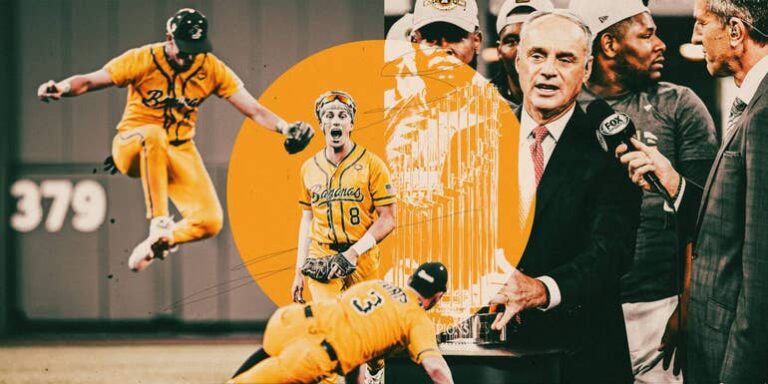As Savannah Bananas Pursue ‘a Billion Fans,’ Are They Real Competition for MLB?
In recent years, the Savannah Bananas have transformed from a quirky collegiate summer league team into one of the fastest-growing sports entertainment brands in America. Known for their bright yellow uniforms, breakdancing players, choreographed at-bats, and circus-like atmosphere, the Bananas have taken baseball’s traditional structure and flipped it into what they call “Banana Ball.” Now, as they boldly set their sights on gaining “a billion fans worldwide,” a question emerges: could this high-energy phenomenon become real competition for Major League Baseball (MLB)?
The Rise of Banana Ball
Founded in 2016 by Jesse Cole, the Savannah Bananas initially competed in the Coastal Plain League, drawing modest attention for their playful in-game antics. But as interest grew, Cole doubled down on the entertainment-first approach, introducing Banana Ball in 2018. The rules are designed for speed, action, and spectacle: games are capped at two hours, batters are out if fans catch a foul ball, and there are no mound visits.
What started as a local experiment quickly became a viral sensation. By 2022, the Bananas were selling out Grayson Stadium in Savannah, Georgia, and racking up millions of views on TikTok and Instagram. Their “World Tour” expanded the brand beyond Savannah, filling ballparks across the U.S. and attracting celebrities, former MLB players, and even international fans.
A Different Kind of Competition
At first glance, comparing the Bananas to MLB might feel like comparing a rock concert to the symphony. Major League Baseball remains the pinnacle of professional play, with global television contracts, billion-dollar franchises, and a century of tradition. But the Bananas are not trying to replicate MLB—they’re challenging the way people experience the sport.
“The Bananas aren’t competing with the Yankees or Dodgers for the World Series,” says sports business analyst Michael Gorin. “They’re competing for time, attention, and cultural relevance. And in that sense, yes, they’re absolutely competition.”
By offering a product tailored to today’s short-attention-span, social-media-driven audience, the Bananas are reaching demographics MLB has struggled with—especially younger fans. While MLB games often last more than three hours, Banana Ball guarantees two hours of nonstop action, entertainment, and viral content moments.
MLB Takes Notice
It hasn’t escaped MLB’s attention that the Bananas are succeeding where the league has stumbled. In recent years, MLB has introduced pitch clocks, limited mound visits, and larger bases—all designed to speed up the game and add excitement. Critics note that many of these changes echo the principles Banana Ball embraced years earlier.
Moreover, the Bananas’ focus on fan engagement is an area where MLB continues to play catch-up. From choreographed dances to mid-inning skits, the Bananas blur the line between players and spectators. The atmosphere feels more like a festival than a game.
Some MLB executives see the Bananas as a laboratory for experimentation rather than direct competition. “We love what they’re doing,” said one anonymous league official. “They’ve found ways to make baseball fresh again. It forces us to think differently.”
The Business of a Billion Fans
Still, the Bananas’ ambition goes beyond fun at the ballpark. Jesse Cole has openly stated his goal of reaching a billion fans globally. While this sounds audacious, the team’s rapid digital growth suggests it isn’t entirely far-fetched. With more than 10 million TikTok followers—more than any MLB team—they’ve already built a global digital presence without traditional TV contracts.
Their touring model also mirrors successful entertainment brands like Cirque du Soleil and WWE. By taking Banana Ball to cities around the U.S., they’re bypassing the limits of a hometown fan base and positioning themselves as a traveling spectacle. International tours are reportedly being considered.
Can They Truly Rival MLB?
Despite the hype, the Bananas face real limitations. Their roster is composed mostly of former college players and independent leaguers, not elite MLB talent. The spectacle is sustainable as entertainment, but not as a replacement for the competitive rigor of professional baseball. For die-hard purists, the Bananas will never replace the thrill of October baseball or the tradition of Opening Day.
Yet the comparison may miss the point. The Bananas aren’t trying to be MLB—they’re trying to be something different, something that blends sport and show in a way uniquely suited to the 21st century. In that lane, they’ve already succeeded.
The Bottom Line
As the Bananas chase their ambitious goal of one billion fans, they may never topple MLB as the dominant professional league. But that doesn’t mean they aren’t competition. In the battle for attention, particularly among younger generations and global audiences, they’ve carved out a distinct, thriving niche.
Whether Major League Baseball views them as a rival or a source of inspiration, one thing is clear: the Savannah Bananas have changed the conversation around what baseball—and sports in general—can look like.
And in an era where entertainment is king, that might make them one of MLB’s most important challengers yet.
